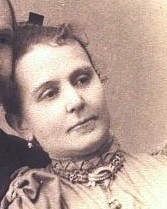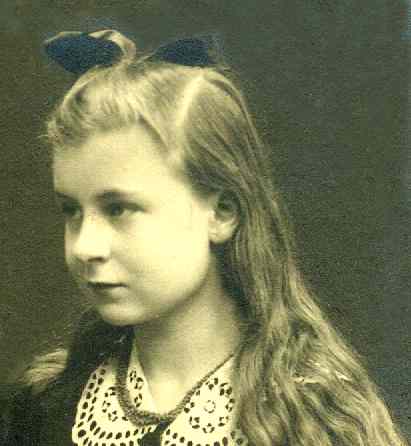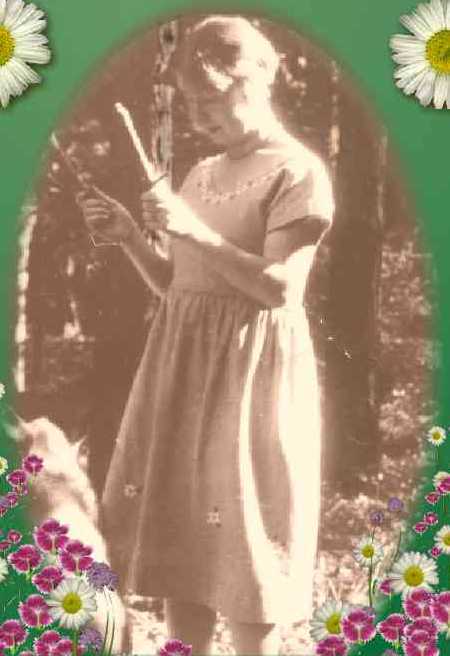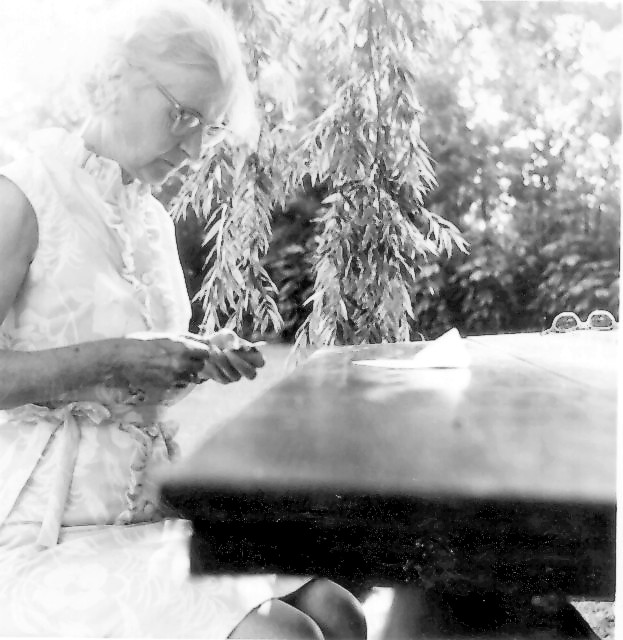
Julie Anna Saefftigen v.
Glehn |
Grandmamma
Glehn (Julie) was a power house, as the
American expression goes. She decided that I
must exclusively wear embroidered white dresses.
Every evening my hair was to be wound around
curlers and then each morning the curls were to
be shaped with a curling iron. I hated that of
course, because it was so boring. She decided
that I only ate a certain kind of chocolate and
refused all gifts of other kinds of chocolate: "
She won’t eat that". I was unhappy, because I
certainly would have. Furthermore she was
convinced that I had to be some kind of a
Wunderkind, because there was so much talent in
the family that it all just had to be condensed
in my small person. When I was all of four years
old I was to have painting lessons. Hence a well
known painter, Clara Feodorovna Zeidler was
summoned from St. Petersburg to develop my great
talent. She only taught master classes. Child
psychology had not evolved yet. The first lesson
required that I should draw and then paint an
autumnal chestnut leaf exactly and
realistically. I erased and erased until the
paper had holes in it; she then spent the rest
of the lesson doing the task herself; but that
meant "Blood and Tears" for me. For her last
class Clara brought in a black felt hat with an
upturned rim decorated with a bunch of cock
feathers. Then she handed me a large white sheet
of paper and a large piece of charcoal. It was
the ugliest hat I had ever seen and I hated it.
Well, trust a four-year old with a piece of coal
and force her to draw a thing she hates with it
!!!!! The coal ended up all over my white dress
and on my face. When grandmother came into the
room, her Forget-me-not blue eyes rolled out of
their sockets. All my clothes were sent to the
laundry, I myself was sent to the bathroom, and
Clara Feodorovna went back to St. Petersburg.
|
My aunt Agnes,
the pianist, was next: trying to teach me to
make music. I soldiered on and made it up to
Schumann’s "Happy Farmer" which I played so
beautifully that the entire family left the
room. I was a flop. My father had his turn when
I turned seven years old. He posed a glass
square ash tray in front of me and bade me draw
it. I had no clue about perspective, and so
everything repeated itself: I erased until holes
appeared in the paper, but the ash tray
obstinately refused to appear standing up, there
always was one side dropping off. After an
hour’s time my father came in to check my
progress. He took a look at my desperate efforts
and said angrily: " You did that very poorly".
He took the ash tray and the drawing pad and
withdrew to his room. I was a zero and no good
and totally below average. A failure. And I
continued to be that in his view. He had dreamed
that I as a twelve- year old would be standing
on a stage playing a violin concerto by Mozart.
Instead I baked cakes in the sand box. |

Agnes at the piano |

Margarethe at age 8
|
I was a late bloomer. When as a nine years
old I came to Zigahnen, I started to draw on my
own. And I started to make up stories, telling
them to Lotte at night. They were extremely
dramatic, sad stories: the stage was littered
with corpses of the heroes, I bawled at their
tragic fates. My one comfort was to draw their
burial sites. I remember a tomb by the sea with
a simple wooden cross underneath a tree; there
my hero rested and listened to the swell of the
waves and the wind in the branches. Sometimes he
rested in a white marble temple in a cypress
garden or under a gothic arch carved into a rock
with torches blazing in eternity and a guard of
honor with drawn swords. I shed hot tears for my
stories and the deaths of my heroes.
|
 |
When I was 12 or
13 years old I saw a silhouette in a shop window
in Marienwerder – I believe it was a Madonna.
That turned out to be my fate. When we returned
home to Zigahnen, I didn’t bother to take off my
fur coat, but grabbed a scissor and some paper
and began to cut a fairy, but she had no neck.
Then I learned to cut in front of a mirror. So
it went all my life long. I had to cut
until this very day. This year I will celebrate
my 60th anniversary. I have told this story many
times in my silhouette lectures, and people have
always been amused by it. |

Margarethe at age 60 |




